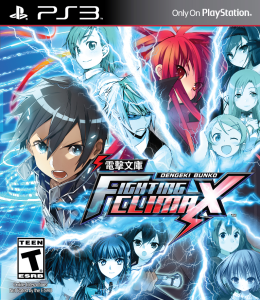 Dengeki Bunko: Fighting Climax is one of those games that was never going to make its way across the pond back in the day. After all, it’s a fighting game primarily targeted at fans of a very specific set of manga/anime characters, with a bit of SEGA nostalgia mixed in to boot as a nod towards its publisher. Normally, the size of the audience here never would have amounted to enough to justify the cost of localization. But fortunately we’re at a moment in gaming where content from Japan flows quite freely thanks to increased interest and reduced costs, so can it capitalize on this growing niche, and does it have a more broad appeal for fans of fighters in general?
Dengeki Bunko: Fighting Climax is one of those games that was never going to make its way across the pond back in the day. After all, it’s a fighting game primarily targeted at fans of a very specific set of manga/anime characters, with a bit of SEGA nostalgia mixed in to boot as a nod towards its publisher. Normally, the size of the audience here never would have amounted to enough to justify the cost of localization. But fortunately we’re at a moment in gaming where content from Japan flows quite freely thanks to increased interest and reduced costs, so can it capitalize on this growing niche, and does it have a more broad appeal for fans of fighters in general?
First of all, the story really won’t have much to appeal to folks unfamiliar with the characters, but the good thing is nobody plays fighters for that sort of thing usually. The main Arcade mode conjures a pretty basic excuse to throw all these universes together. A bad guy named Zetsumu is full of so much despair that he begins hacking all these worlds, copying character data, and destroying dreams. Whichever character you choose is the final “Envoy of Hope” charged by Deshima (actually a personified Sega Dreamcast from the Sega Hard Girls anime) to defend those dreams and get everyone back. More interesting for actual fans of the anime and manga represented in the game is the new Dream Duel mode, which includes new lines of dialogue between the characters that highlight some of their similarities and differences in amusing ways. For instance when playing as Miyuki Shiba (The Irregular at Magic High School), the other magic users she fights are confused by the way her magic works, which is more scientific looking rather than occult. The roster also includes Asuna and Kirito (Sword Art Online), Taiga (Toradora!), Shizuo (Durarara!!), Kirino (Oreimo), Mikoto Misaka (A Certain Magical Index), Kuroyukihime (Accel World), Rentaro (Black Bullet), Yukina Himeragi (Strike the Blood), Shana (Shakugan no Shana), and Tomoka Minato (Ro-Kyu-Bu!). There’s also several assist characters from each of those series and others.
The actual fighting itself somewhat sits between Smash Bros. and the more classic Street Fighter style of gameplay. While it’s not as simple as pressing a single button to execute special moves, it never gets more complicated than quarter circles and half circles, and each character’s move list basically consists of these same core elements, so switching characters doesn’t require learning anything new to do the specials at least. There is still a good amount of skill and tactics to be learned as far as the differences between characters, though. Some are better at long range while others are easier to chain combos with (though it should be noted there are no crazy endless combos as far as I can tell). The same goes for the assist characters, which tend to be more effective paired with their counterparts from the same series, but can be fun to experiment with as well. Still, there are some things that fighting game veterans may find cheap, like the “Trump” moves which are basically a one button press to do a healthy chunk of damage from close range, though you only get two per match and they can be evaded. There’s also the “Blast”, which can be used to charge your special meter quite rapidly or to break a combo, though those run on a timer so can only be used sparingly. Admittedly I’m not a fighting game expert, so my commentary on this portion might be somewhat limited, but it feels perfectly targeted at someone like me who loves the characters and wants to jump in without being overwhelmed, and the perfect evidence of this is the fact that I was actually able to win matches online unlike every other fighting game I’ve tried in the past.
So yes, there is multiplayer, and it works fairly decently on both the PS3 and the Vita, with ranked matchmaking as well as the ability to create custom rooms with your own rules and invite friends only. Some lag is noticeable at times but nothing game breaking and you can limit matchmaking to your region to help that a bit. Playing the game gives you credits to unlock fancy nameplates, titles, icons, and new colors for the characters so there’s a lot of room for customization (you can also spend those points to reveal new art as well as the sound clips and letters from the voice actors, a nice touch!). There’s also a local versus mode, training, and a couple challenge modes like score and time attacks as well as a survival mode. All pretty standard fare for a fighting game nowadays but it’s still good to see. The best part is if you own the PS3 and Vita versions, there’s a cross save function, so you can share all your unlocks between the two.
Speaking of which, both versions are perfectly interchangeable, playing exactly the same with perfect framerate and controls (obviously the smaller buttons on the Vita make somethings a little more difficult, but not impossible). The characters look great on the big screen of the PS3 and scale down nicely for the Vita, though pixelization is more noticeable on the later. I love the animations, particularly of the super attacks, many of which are very canonical to the source material (see Taiga kicking her opponents into a light post, or Mikoto shooting a huge bolt of lightning from her arm), while others are incredibly creative like Kirino’s cosplay inspired combo. The pre fight banter and post fight celebrations are similarly inspired. Backgrounds meanwhile are taken from various Sega games like Sonic and Valkyria Chronicles. There’s not much going on in them, unfortunately, but it’s still a neat touch. I’m also appreciative of the plethora of voice acting talent that showed up for this game, as nothing was left out or overlooked in that regard, and the music does enough to engage without being overbearing.
I would ultimately say that Dengeki Bunko: Fighting Climax is more of a love letter to fans of the source material than something directed at fighting game fanatics, and it succeeds greatly at that. It should also have appeal to those who want to play a fighting game that isn’t so hardcore, but also isn’t something completely different like Smash Bros. If you’re a veteran looking for a serious challenge, you might want to look at the developer French Bread’s previous work, Under Night In-Birth, which is a more original experience. In any case, here’s hoping for sequels with expanded rosters in the near future!
Gameplay
Graphics
Sound
Overall


